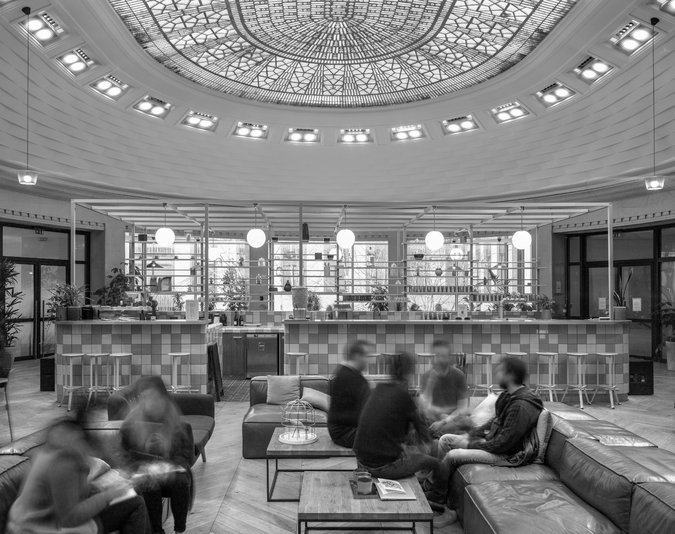IMAGINE YOU TRAINED an artificial intelligence on a comprehensive stock-photo set of every boutique-hotel lobby from Palm Springs to Stockholm to Milan, then connected it to a five-story 3-D printer fully furnished with pendant-dome lamps, waxy leaves and old-school hip-hop lyrics. The output would be a WeWork. So much serene, lavish and mechanical attention is allocated to every detail: the neon and the daybeds and the fiddle-leaf figs, the wallpaper and the playlists and the typefaces. The newest iteration of its ever-emergent design concept may be indebted to Luis Barragán and Carlo Scarpa, but the degree of thought and investment that goes into its terrarium construction is something its busy occupants are expected to register only as background noise. WeWorks feel voguish but never threatening; comfortable but never shabby; rousing but never intemperate; detailed but never ostentatious.
There’s also free top-shelf coffee, the sort of minor frill most office workers might take for granted in a way the self-employed never would. One premise of the company’s existence is that it’s good business to provide such minor luxuries to the otherwise unfrilled. The coffee — and the draft kombucha, which has come to supplement beer as WeWork distances itself from the frattier aspects of entrepreneurship — is, at any rate, only part of an environment engineered for felicitous exchange. This strategy is supported by narrow hallways, boxy plate-glass enclosures, distant bathrooms and centralized fruit-water dispensers, but the company’s architects never indulged the belief that if they built it, people would come. The spaces themselves are the staging ground for yoga classes, wine tastings, make-your-own-trail-mix bars and vendor workshops about how to cut cloud costs. For what remains of life outside the workplace, there are cross-promotional discounts on 1-800-Flowers.com and Crunch gym memberships.
Most of us have serious reasons to worry about the future of work, and it’s easy to object to WeWork’s thin consolations on the basis of aesthetic or moral principle. Once you get accustomed to the basic product, however, it’s hard not to find it ... pretty nice. Over the course of about a year, I stopped into locations in six or seven cities, and in each of them I sat in front of my computer alongside other people in front of their computers and felt at once marginally more productive and slightly less unmoored.
My “home” location — on North Fourth Street in Williamsburg, Brooklyn, next to the Whole Foods across from the Apple store — was proposed to me, by WeWork’s unusually thoughtful and candid public-relations representatives, as a particularly strong example of the company’s “community layer” at work. The “community manager,” Natalie, is a luminous young woman with flaming scarlet hair and a rockabilly swagger. She started as the location’s first front-desk associate and rose quickly to her current role as operational czar, personal concierge and on-call therapist; she has also been recruited, in her capacity as a “theatrical jazz pop” singer, to perform at companywide events. She has first-name-basis relationships with everybody. She knows when the printer by the sunglasses and accessories manufacturer is going to run out, and when Ulrik, the chief executive of the Danish software-platform company that is the location’s largest tenant, is arriving on a red-eye and will require early-hours access. She was quick to put together canned-food and used-clothing drives on the occasions of disasters, and encouraged everyone to sign up for a marrow-donor registry. Community managers remember people’s birthdays and their preferences in candy or whiskey and their dogs’ preferences in treats.
If Natalie was everyone’s favorite quasi comptroller, it was clear that everyone’s favorite quasi co-worker was a young accountant named Mabel Luna. When she was 18, Mabel moved from the Dominican Republic to the Bronx. She put herself through school and worked for three of the Big Four accounting firms until she decided her heart was not in capital markets but in small companies. It was the idea of her own office, which she selected before the space had a floor, that gave her the confidence to start a business — a common sentiment at WeWork and one I heard particularly often from women and people of color — and on move-in day, she hung up her shingle as a private C.P.A. Though she never advertised, she quickly outgrew herself; she told me that 90 percent of her customers have come through WeWork, either via hallway run-ins or through the social-networking features of its mobile app. She had several clients in the building — including a brewer of natural alcoholic kombucha, a sole-proprietor attorney and the German sunglasses manufacturer by the printer — and saw herself as much more than an arm’s-length contractor. The only real glitch was that her friend-client-colleagues were constantly stopping by to rap on her window with a quick question about cash flow or depreciation, or to ask if she could spare an hour for a kombucha-tasting panel or some volunteer hand-modeling. During tax season, she felt as though she had to leave WeWork to get any work done.


